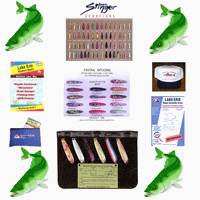Late Season Perchiní
by Rick Olson
There really isn't anything fancy about late ice perchin' and the
whole process can be rather simple. You can boil most of it down to three
thing basic things: location, location, and location. The fact is; if
you can find them you can probably catch them, although a fine tuned
presentation will probably help you more fish in the bucket.
process can be rather simple. You can boil most of it down to three
thing basic things: location, location, and location. The fact is; if
you can find them you can probably catch them, although a fine tuned
presentation will probably help you more fish in the bucket.
Finding perch late in the winter typically begins and ends with basin
areas. Sure there are other spots where late ice perch will sit up shop
but it's the basin that can hold the key to finding real jumbos. Here in
North and South Dakota we have a ton of lakes that were once duck
sloughs and many are now loaded with giant yellow perch. We'll search
the deepest water in these sloughs for schools of roaming perch and
includes the ten to twenty and even up to thirty foot range, depending
on what's available. Mille Lacs Lake in central Minnesota is a sprawling
natural lake that is known for producing monster perch and late ice
location is surprisingly similar with some of the biggest perch coming
miles off shore in deeper basin areas. This late season scenario
repeats itself over and over again throughout the Midwest and is a
pattern definitely worth exploring.
There aren't that many good short cuts to finding basin running perch
but there are a few, including gathering as much information as you can
and networking with other anglers. Bait shops can be a real gold mine of
info and are always worth a call or stop. They want to see you succeed
because if you do you'll be back, and next time you'll probably bring
your friends along. Networking can be as simple as hitting the ice with
a couple of friends and sending them all in different directions and
covering as much water as possible. Somebody can take the north end, the
south end, the really deep water, or maybe the mid range stuff. By
covering all of the bases you can narrow it down in a fraction of the
time it would normally take and quickly put you on top of the hottest
fish available.
Punching a lot of holes through late ice is usually mandatory and is
where a gas powered auger can be an absolute must. Late ice can be
thick, two to three feet thick, and thereís no way you can cut enough
holes and cover enough ground with anything less. A sled or a four
wheeler is another important tool that can help keep you mobile, and
maybe be your only option when shoreline ice starts to deteriorate.
It doesn't take long once you've drilled a few holes to know if your
on the right fish because they'll quicklyshow themselves on a depth
finder and will gobble up the right bait without hesitation. If youíre
over the right fish theyíll show up on a depth finder just about as soon
as you drop a bait in front of them, so you really donít want to waste a
lot of time angling when you should be on the move. So how much time
should you spend working a hole? It will depend on how much time you
have and how much water you need to cover but typically ten or fifteen
minutes should do it. If they havenít at least shown up on the depth
finder by then theyíre not there. If theyíve shown up but havenít taken
a bait you may have to spend a little more time and tweak your
presentation. That could mean a change in lure color, or minnow size, or
holding it perfectly still, etc.
Time of day can also play a factor and peak periods include morning,
mid day, and evening hours. Just exactly when perch can be expected to
turn on from day to day can vary and youíll have to figure that on out
for yourself. A fine tuned presentation includes using smaller jigs like
Northland Tackleís Forage Minnow tipped with crappie minnows and
suspended below a slip bobber, but not necessarily the answer to
catching the largest of the species. If youíre looking for real jumbos;
bigger minnows like big fatheads may be the answer, even if it feels
like youíre using a bait more apt to appeal to walleyes. A pound and
half perch will take on anything a pound a half walleye will, so donít
be afraid to use a larger bait. Even though Iíll usually be using a slip
bobber, that doesnít mean Iíll be sitting back and waiting for it to
sink out of sight. Instead; Iíll watch the float to see that itís
dancing due to an active minnow and if itís not; Iíll pick up the rod,
jiggle it, and then set it back down. That small amount of action can
get your minnow moving again and attract and trigger roaming bands of
perch.





 process can be rather simple. You can boil most of it down to three
thing basic things: location, location, and location. The fact is; if
you can find them you can probably catch them, although a fine tuned
presentation will probably help you more fish in the bucket.
process can be rather simple. You can boil most of it down to three
thing basic things: location, location, and location. The fact is; if
you can find them you can probably catch them, although a fine tuned
presentation will probably help you more fish in the bucket.